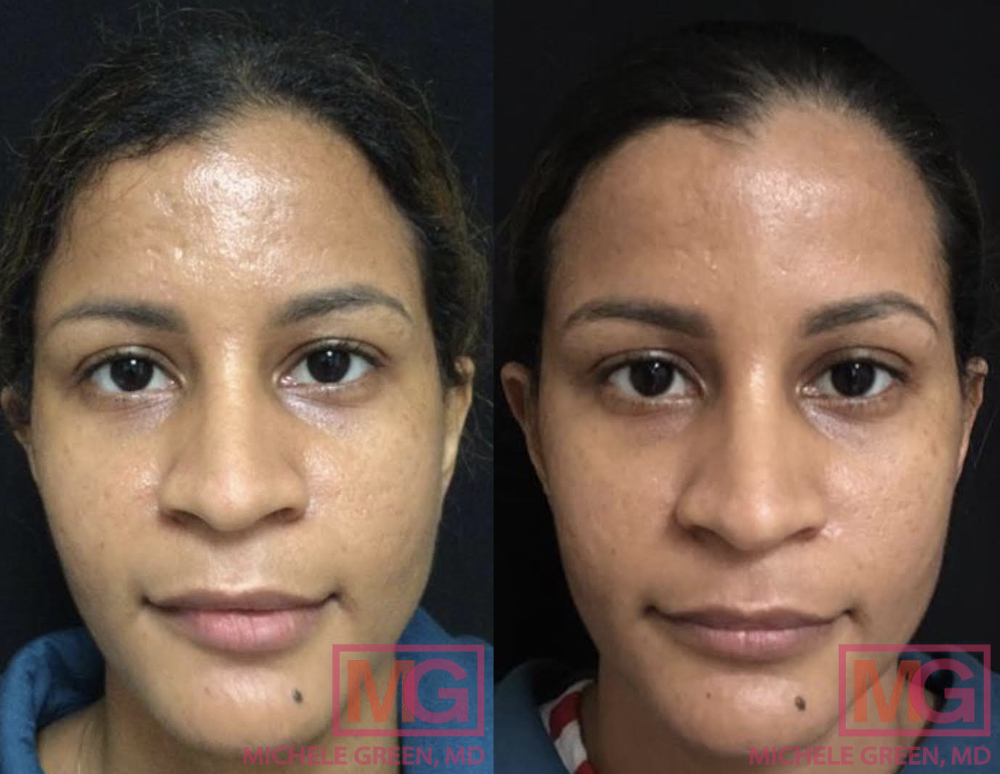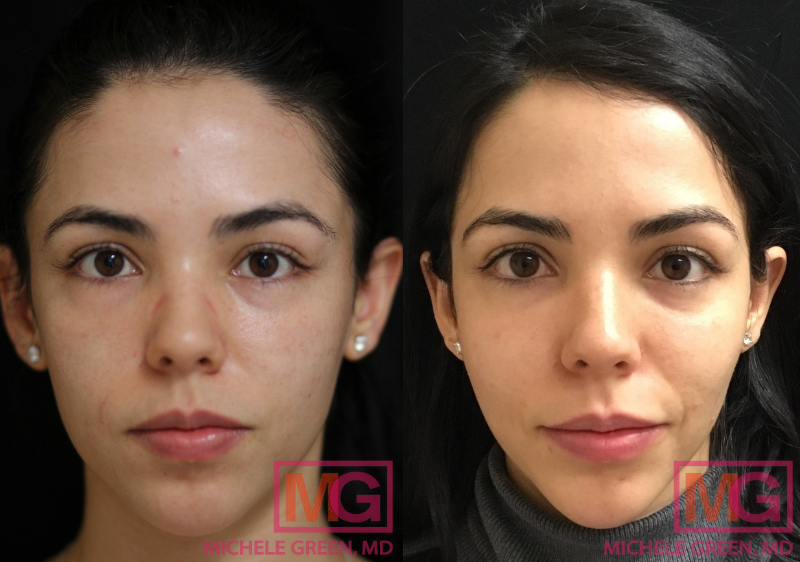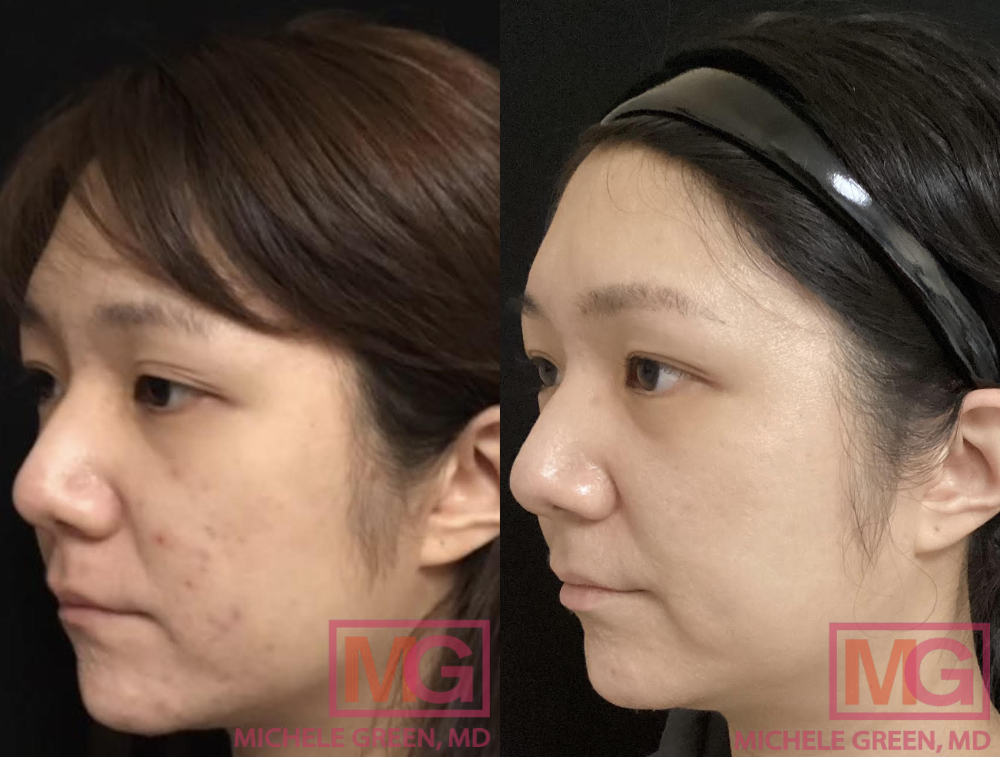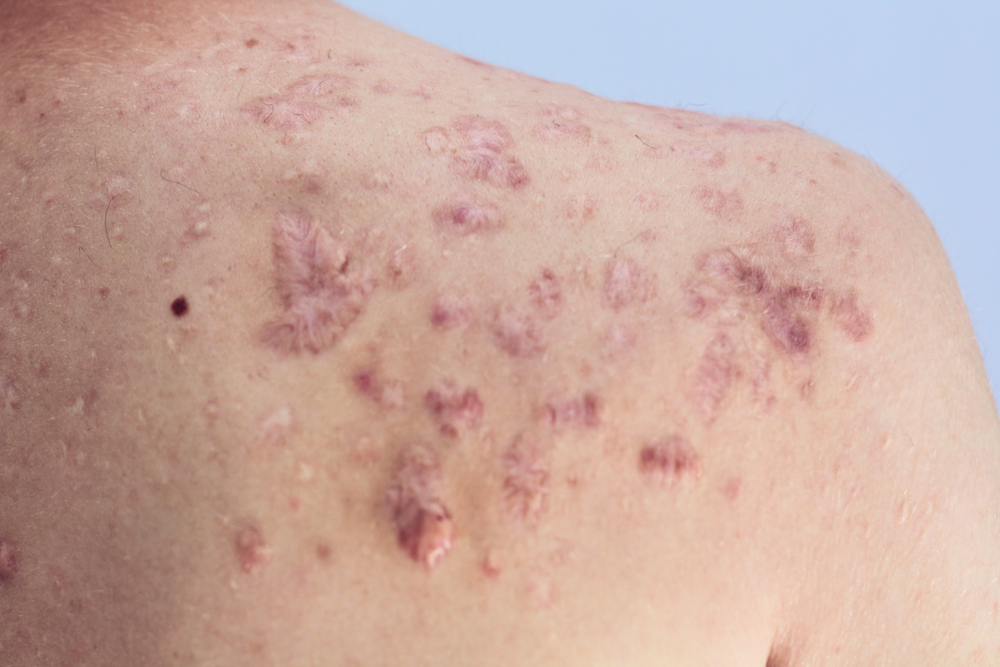Boxcar Acne Scars
Acne is one of the most common skin conditions in the world, affecting millions of Americans each year, according to the American Academy of Dermatology. But while acne breakouts themselves are frustrating and often painful, the effects of severe acne can linger in the form of acne scars. Acne scars form due to insufficient or excessive collagen production during wound healing, leading to atrophic acne scars or hypertrophic scars, respectively. Atrophic acne scars, or scars in which a lack of collagen lead to depressions on the skin’s surface, and be further broken down into three scar types: ice pick scars, rolling scars, and boxcar scars. Characterized by rounded or oval craters in the skin with well-defined edges, boxcar acne scars can form when inflammatory acne or acne lesions remain untreated for too long. Once formed, boxcar scars will not go away on their own. Luckily, many effective treatment options for reducing the appearance of boxcar acne scars are available at Dr. Michele Green’s New York City dermatology office.
As a wide range of cosmetic procedures works to treat acne scars, the best first step is to consult an expert, board-certified dermatologist, such as Dr. Green. Once Dr. Green has examined the skin scars and texture, she will decide the acne scar treatment that will be most effective for you. For some patients, Dr. Green may recommend a skin resurfacing treatment, such as chemical peels, dermabrasion, or Fraxel laser treatment, to encourage skin cell turnover and improve skin texture. Collagen induction treatments, such as microneedling or the eMatrix laser, also trigger the body’s natural healing response to fill in depressed skin tissue. A mild surgery, such as punch excision or subcision paired with dermal fillers, may be the ideal solution for some patients. With Dr. Green, you will receive safe, effective, and individualized acne scar treatment to improve skin texture and reduce the appearance of boxcar scars.
Board-certified dermatologist Dr. Michele Green has been expertly treating patients for more than 25 years. Well-versed in a wide range of cosmetic and medical dermatological procedures, Dr. Green is one of the top providers in New York City of treatments such as dermal fillers, chemical peels, Botox, microneedling, laser treatments, and much more. Dr. Green is well-known for creating individualized and effective treatment plans for all patients and has been frequently voted one of the best healthcare providers in New York City by such publications as New York Magazine, Super Doctors, and Castle Connolly.
What are the different types of acne scars?
The two main types of acne scars that can form from inflammatory acne are atrophic acne scars and hypertrophic scars. Atrophic acne scars are the most common type of acne scar and form when not enough new collagen is produced during the healing process following a severe acne breakout, leading to indents or depressions on the skin’s surface. Atrophic acne scars can be further broken down into three types of depressed scars: icepick, rolling, and boxcar scars. Icepick scars are deep, narrow indents that look like the area has been stabbed with a thin sharp object, such as an icepick – hence the name. Rolling scars are characterized by uneven, sloping edges that give the skin a wavy, uneven texture, while boxcar scars are oval or round indents with sharp edges. Atrophic scars can be shallow depressions, but deep boxcar scars, icepick scars, and rolling scars can form when the infection present in the nodules or cysts is particularly deep.
The second overarching type of acne scar is the hypertrophic acne scar, or raised scar, which can take on the form of keloids or an excess of scar tissue. During the wound healing process for some patients, an overproducing of collagen occurs, causing tissue buildup and a raised appearance to the area. Often, hypertrophic scars will have a surface area that extends beyond the area of the initial breakout. Keloid or hypertrophic scars will not go away on their own and need to be medically removed.
Severe acne can also lead to post-inflammatory hyperpigmentation or discoloration and redness at the breakout site. When it comes to treating acne scars, treating the depression in the skin and the discoloration of the scarring will require a combination approach to eliminate all signs of the acne scars.

What are the symptoms of boxcar acne scars?
Boxcar acne scars are a type of atrophic scar, meaning that not enough of the structural proteins collagen and elastin were produced during the healing process, leading to indentations or craters on the skin’s surface. Unlike icepick scars that are deep and narrow, boxcar scars have wider depressions that can be deep or shallow. Boxcar scars also differ from rolling scars in that rolling scars are characterized by sloping edges, while boxcar scars have sharp edges. Hyperpigmentation in boxcar scars can occur, meaning that boxcar scars can be red or dark in appearance, though some patients find that boxcar scars appear to be the same color as the surrounding skin.
What causes boxcar scars?
The pathogenesis, or cause, of boxcar scars, is associated with the healing process following a breakout of nodular or cystic acne. Acne breakouts occur when the pores are clogged with excess sebum – the natural oil found on the top layer of skin – dead skin cells and other debris. When the pores become infected with bacteria, inflammatory acne occurs and can lead to painful nodules or cysts, which, when left untreated for a long period, can inhibit the healing process following the breakout, leading to the formation of acne scars. Atrophic acne scars, such as boxcar scars, form when insufficient amounts of new collagen are produced, which leads to craters on the skin’s surface. And often, deeper infection from the acne breakout leads to deeper scars.
Why do boxcar acne scars happen?
According to the American Academy of Dermatology, researchers are still unclear on why certain people are more likely to experience atrophic acne scars versus hypertrophic scars or why some patients do not experience scarring. Certain risk factors may increase the likelihood of developing boxcar acne scars following a breakout:
- Developing severe inflammatory acne, including the appearance of cysts or nodules
- Leaving cystic or nodular acne untreated for an extended amount of time
- Popping or squeezing pimples, which can lead to a wider-spread infection or force bacteria deeper into the inflamed pores
- Having a family history of boxcar scars
Patients can decrease their risk of developing acne scars by treating severe acne early and refraining from touching or squeezing pimples.
Do boxcar scars go away?
While boxcar scars may slowly fade over time, they are permanent and will never fully go away on their own. Acne scars often frustrate patients and result in a permanent blemish on the face, which can lower self-esteem. Luckily, patients can turn to the wide range of cosmetic treatments available at Dr. Green’s dermatology office to eliminate or reduce the appearance of atrophic boxcar scars.
What is the best way to get rid of boxcar acne scars?
The best way to get rid of boxcar acne scars is often through a combination approach, meaning the use of several different cosmetic procedures for more effective elimination of the scarring. Boxcar acne scars are often characterized by skin indentations and discoloration, which are best addressed using different treatment methods. When you have your initial consultation with Dr. Green, she will examine the treatment area to develop your individualized treatment plan, taking into account the depth and severity of the scarring, skin texture, and skin type. Depending on these factors, Dr. Green may turn to different types of lasers, different concentrations of chemical peels, or other collagen induction or skin resurfacing treatments, such as microneedling or microdermabrasion. No treatment is considered “the best,” Dr. Green will help determine which treatment is best for you.

How to get rid of boxcar acne scars with Microneedling
Microneedling, sometimes called collagen-induction therapy, is a treatment in which controlled micro-injuries are created on the epidermis to trigger the body’s natural healing response. When treating boxcar acne scars, tiny, surgical-grade needles are used to pierce the skin, which boosts collagen production in the treatment area, improving the skin texture and reducing the appearance of indents. The procedure is non-invasive, requiring no downtime following treatment and no risk of serious side effects. Dr. Green will often pair Microneedling treatment with platelet-rich plasma (PRP) infusions. When applied to the treatment area, the platelet-rich plasma in the patient’s blood is absorbed into the tiny holes created by the Microneedling to help with the natural healing process.
How to remove boxcar scars with chemical peels
Chemical peel treatments come in varying depths and concentrations and work by applying an acid solution to exfoliate the epidermis for smoother, clearer, brighter skin. Chemical peels come in three different depths: mild or superficial peels, which are best for minor acne breakouts, fine lines, and mild sunspots or hyperpigmentation; medium-depth peels, which are effective for reducing the appearance of acne scars, fine lines, melasma, and uneven skin tone and texture; and deep peels, which are the most powerful type of chemical peels and are most commonly used for eliminating early signs of skin cancer.
When treating boxcar acne scars, Dr. Green will most frequently use a trichloroacetic acid (TCA) peel, which is a medium-depth peel that works to penetrate the deeper layers of skin to promote skin cell turnover. Dr. Green will apply the trichloroacetic acid peel in a process known as a TCA cross, which involves the application of the acidic solution directly to the boxcar scars. The peel creates a “frost” over the scar, leading to peeling in the area over the next several days, improving the skin texture. A TCA cross is best used for shallow to medium-depth boxcar scars.
How to treat boxcar acne scars with laser therapy
Several types of laser treatments are effectively used to reduce the appearance of boxcar acne scars, including the Fraxel laser, eMatrix laser, and VBeam laser. Each type of laser works differently and can even be combined to improve skin texture and tone and combat hyperpigmentation from scarring.
Fraxel Laser – The Fraxel laser uses fractional laser technology to resurface the top layer of skin for smooth, evenly toned, and textured skin. By creating controlled micro-wounds in the dermis with fractional energy, the Fraxel laser triggers the body’s natural healing process, which boosts collagen production in the treatment area. The increase of new collagen helps to fill in the depressions on the skin for improved texture. Dr. Green recommends five to six treatment sessions spaced a month apart for the best results.
eMatrix Laser – The eMatrix laser uses radiofrequency energy to improve the appearance of boxcar scars for patients of all skin types, including those with darker skin. When applied to the treatment area, the eMatrix laser emits targeted wavelengths of radiofrequency energy to trigger the body’s natural collagen production, improving the skin’s texture. As the treatment takes advantage of the body’s natural collagen production processes, the results of the treatment continue to improve over time, with full results becoming visible 3-6 months post-treatment.
VBeam Laser – The VBeam laser uses wavelengths of light to target redness and hyperpigmentation often present in scar tissue. Some boxcar scars are characterized by discoloration at the site of the scar, which can often make the depression in the skin more noticeable. The VBeam laser targets this discoloration with light energy absorbed by the pigmentation in the tissue. It is converted into heat energy, destroying the pigmentation while leaving the surrounding skin unaffected.
How do you get boxcar acne scars?
Boxcar acne scars can be formed due to severe acne breakouts that become infected with bacteria or pus, leading to nodular or cystic acne. Not everyone who experiences nodules or cysts will necessarily develop boxcar acne scars, and researchers are not entirely sure why some patients are more susceptible to atrophic acne scarring. Researchers do know, however, that depressed acne scars, such as boxcar scars, are formed when severe inflammatory acne inhibits the healing process, leading to insufficient new collagen production. Collagen is a protein that gives structure to the skin, and not enough collagen production leads to indents and depressions in the skin’s surface, forming boxcar scars.
What can you do to avoid boxcar acne scars?
One of the major risk factors for developing acne scars is the development of severe inflammatory acne that remains untreated for an extended amount of time. As such, one of the best ways to avoid boxcar scarring is to treat the breakout of inflammatory acne early and with the help of a board-certified dermatologist, such as Dr. Green. With severe acne, over-the-counter products are often ineffective at eliminating the breakout, which requires patients to turn to prescription products. With her proprietary MGSKINLABs, Dr. Green has a range of skincare products, such as topical retinoids and other prescription topical products, to dry out and unclog the pores. In some cases, Dr. Green may prescribe antibiotics to eliminate the acne-causing bacteria trapped in the hair follicles, which will also help to clear the breakout. Side effects of these products may include dry skin or redness.
Mild chemical peels, such as glycolic acid and salicylic acid peels, can also help with active acne breakouts by resurfacing the skin, unclogging the pores, and promoting skin cell turnover. For severe cases, Dr. Green may turn to a mild surgical procedure to open the acne lesion and unclog the pore, paired with corticosteroid injections, which improves the inflammation in nodules and cysts.

Do acne scars get worse with age?
As a part of the natural aging process, the production of the structural proteins collagen and elastin begins to decrease, and, as a result, the skin starts to sag, and fine lines appear on the skin’s surface. Decreased collagen production also contributes to the heightened appearance of atrophic acne scars. As collagen production slows, the indents in the skin become increasingly more noticeable over time. Many acne scar treatments help eliminate signs of acne scars and reduce signs of the natural aging process. When treatments such as chemical peels, microneedling, and laser treatments boost collagen production to fill in the acne scars, it also improves skin tone and texture for smooth, bright, youthful-looking skin.
What is the hardest acne scar to treat?
Acne scars that leave deep indents on the skin’s surface are often the hardest scars to treat, including ice pick scars and deep boxcar scars, as it can be especially challenging to fill in the deep depressions. Deep acne scars typically require a combination approach to treatment, meaning pairing multiple treatments together to gain the best possible results. Dr. Green may use a higher-concentration chemical peel or non-ablative laser resurfacing treatment to boost collagen production and promote skin cell turnover in treating deeper acne scars. Dr. Green may also use dermal fillers, such as hyaluronic acid fillers, or a poly-L-lactic acid filler like Sculptra to restore lost volume. When you have your initial consultation with Dr. Michele Green, she will create a treatment plan to reduce the appearance of even the toughest acne scars.
What is the difference between keloid scars and atrophic scars?
Keloid scars and atrophic scars differ in appearance and formation. While atrophic scars are depressions that form on the skin’s surface, keloid scars are raised scar tissue, creating bumps that often extend past the surface area of the original lesion. Where atrophic scars are formed due to insufficient new collagen production during the healing process, keloid scars are formed due to an overproduction of collagen. Researchers are still unsure why certain patients are more susceptible to the formation of keloid scars, but if that is the case for you, be sure to inform Dr. Green before undergoing any ablative procedures.

How do I get started with acne scar treatment today?
Acne scars can often be even more challenging to treat than the initial breakouts themselves and, for many, cause feelings of self-consciousness and low self-esteem. If you’re frustrated by the appearance of acne scars, there are solutions available that can help greatly reduce them and help restore your self-confidence. Dr. Green offers a host of acne scar treatment options in her NYC dermatology office, including laser treatments, microneedling, subcision with dermal fillers, chemical peels, and microdermabrasion, among others.
Dr. Michele Green in NYC is an internationally renowned board-certified dermatologist with over 25 years of experience providing some of the world’s most discerning individuals with the best non-invasive cosmetic procedures available, including treating acne scars and acne. Dr. Green takes a holistic approach and embraces a less-is-more philosophy regarding rejuvenation, carefully customizing each patient’s treatment plan to cater best to their specific skin concerns and overall aesthetic goals. For her dedication to her patients and expertise, Dr. Green is consistently identified as one of New York City’s best dermatologists by Castle Connolly, New York Magazine, and Super Doctors. When you consult with Dr. Green at her private dermatology office in Manhattan’s Upper East Side, she will work with you to eliminate your acne scars and reveal a smooth, clear, healthy complexion that lasts. To find out which treatment options are best for you, schedule your initial consultation with Dr. Green by calling the NYC office at 212-535-3088 or by contacting us online today.
 212-535-3088
212-535-3088